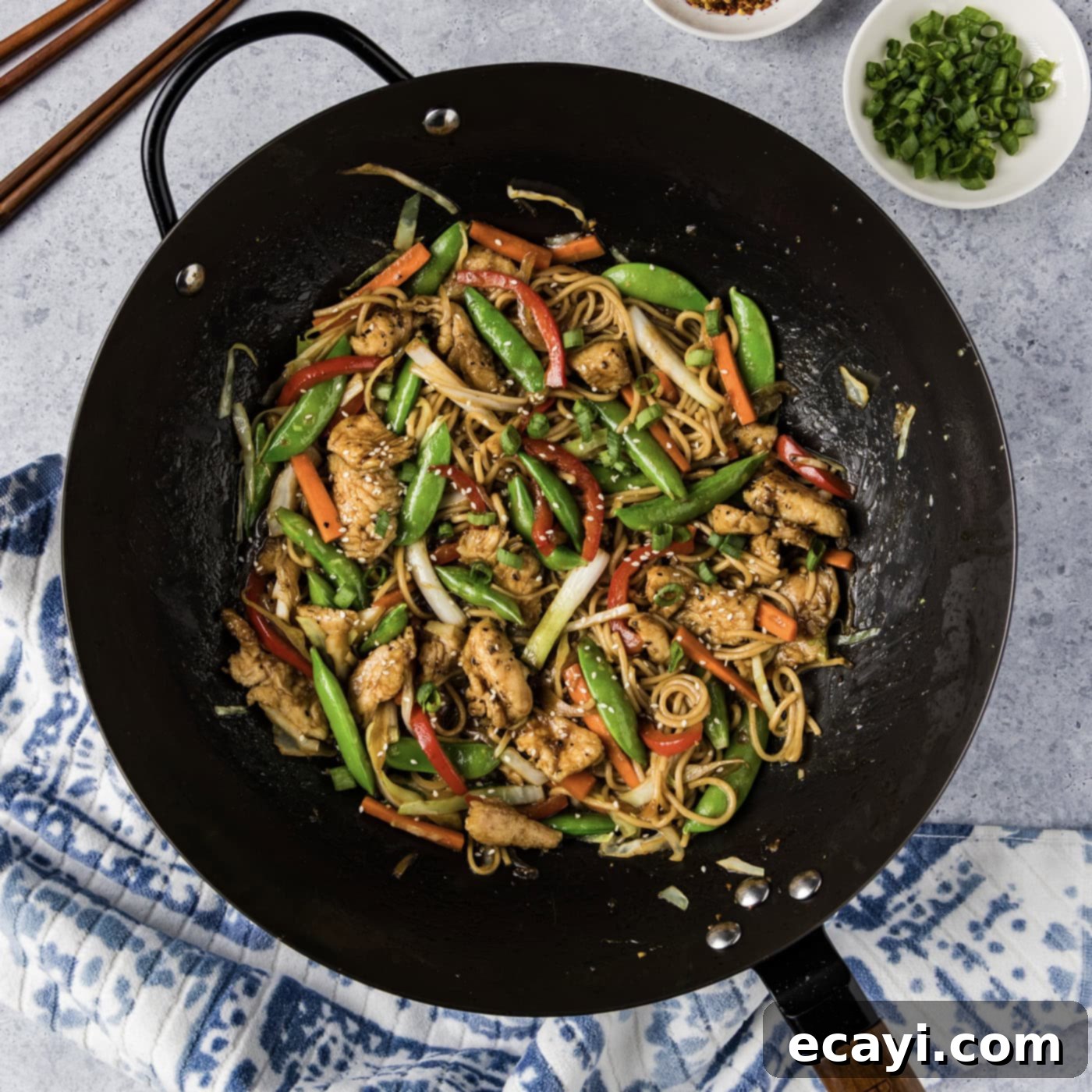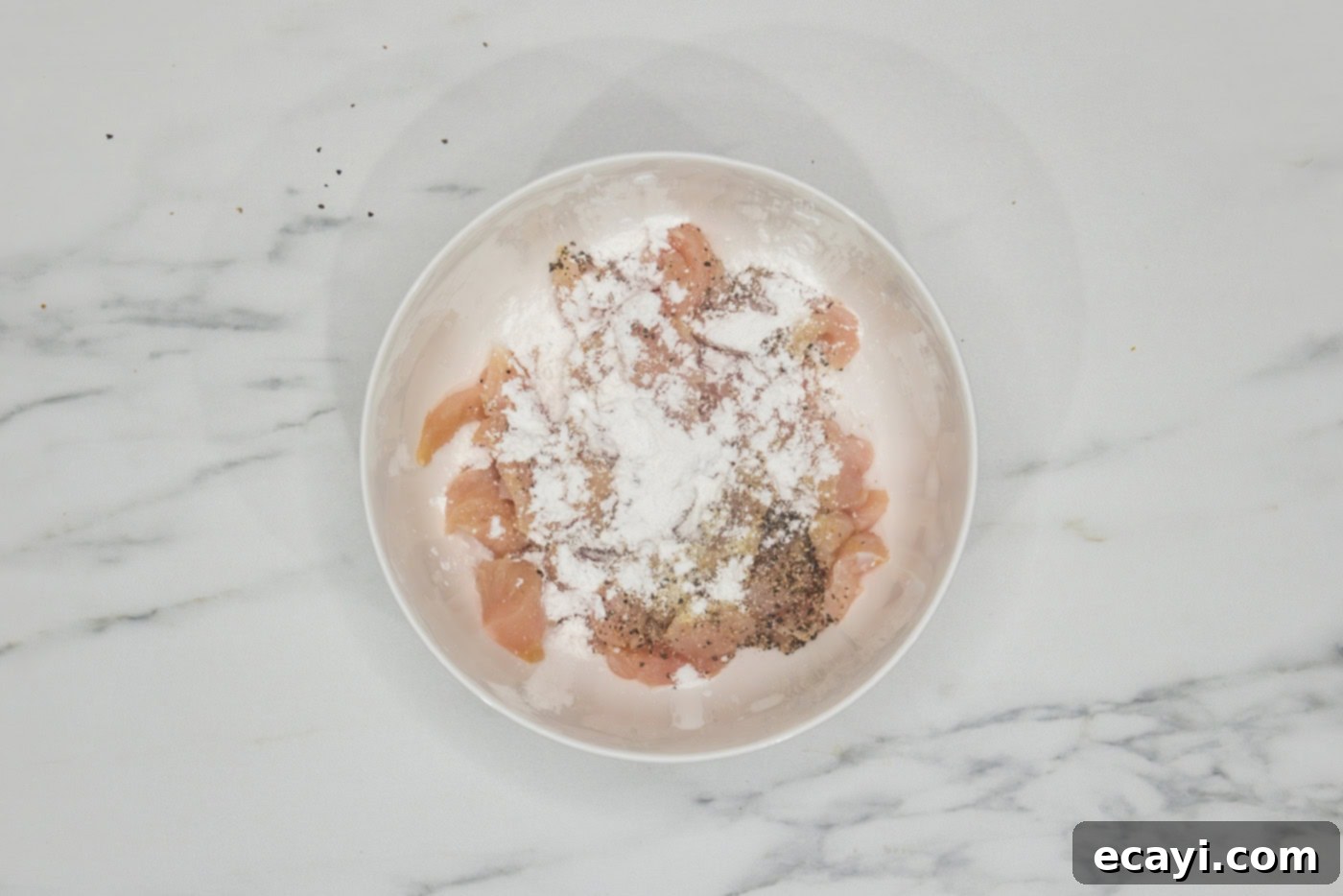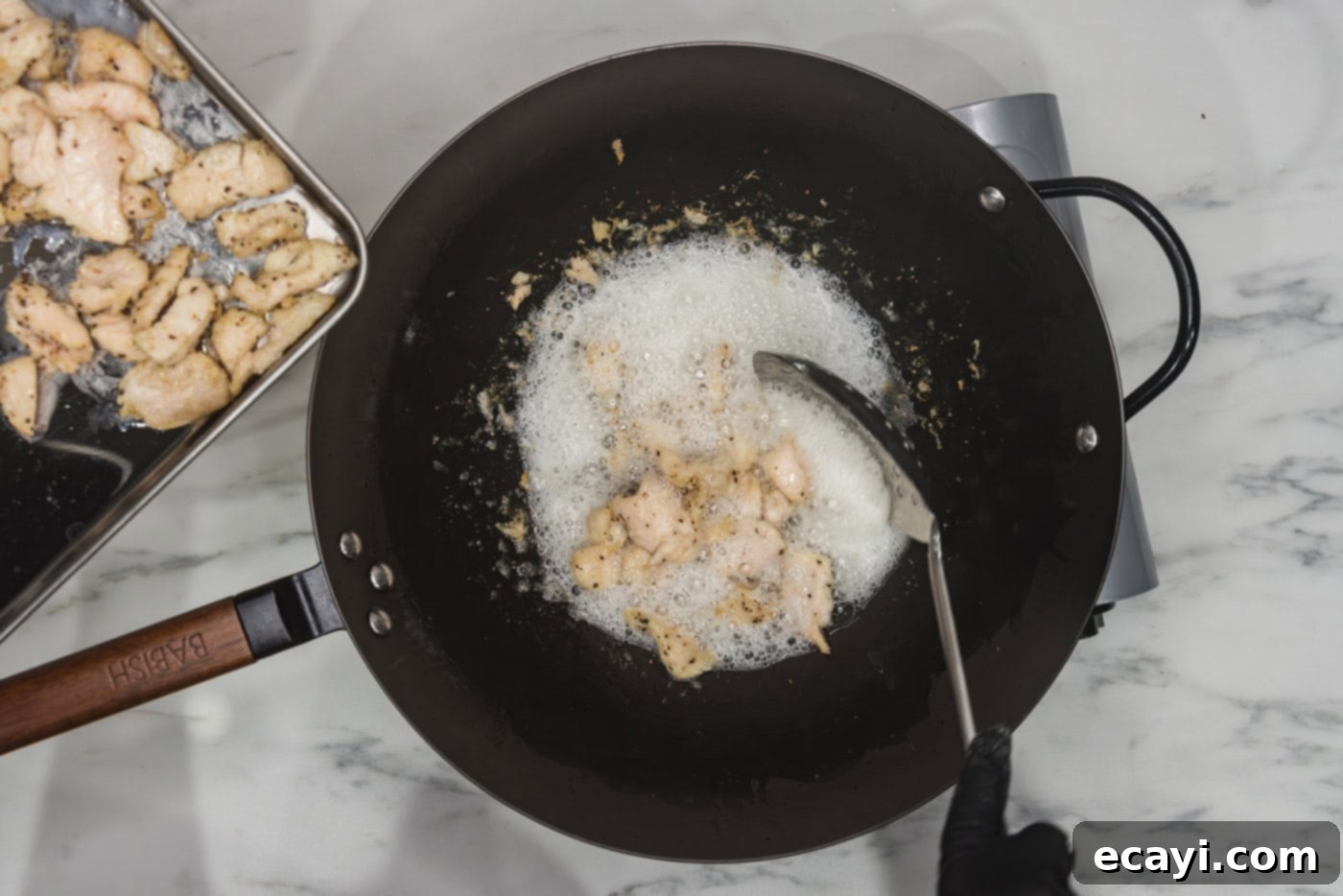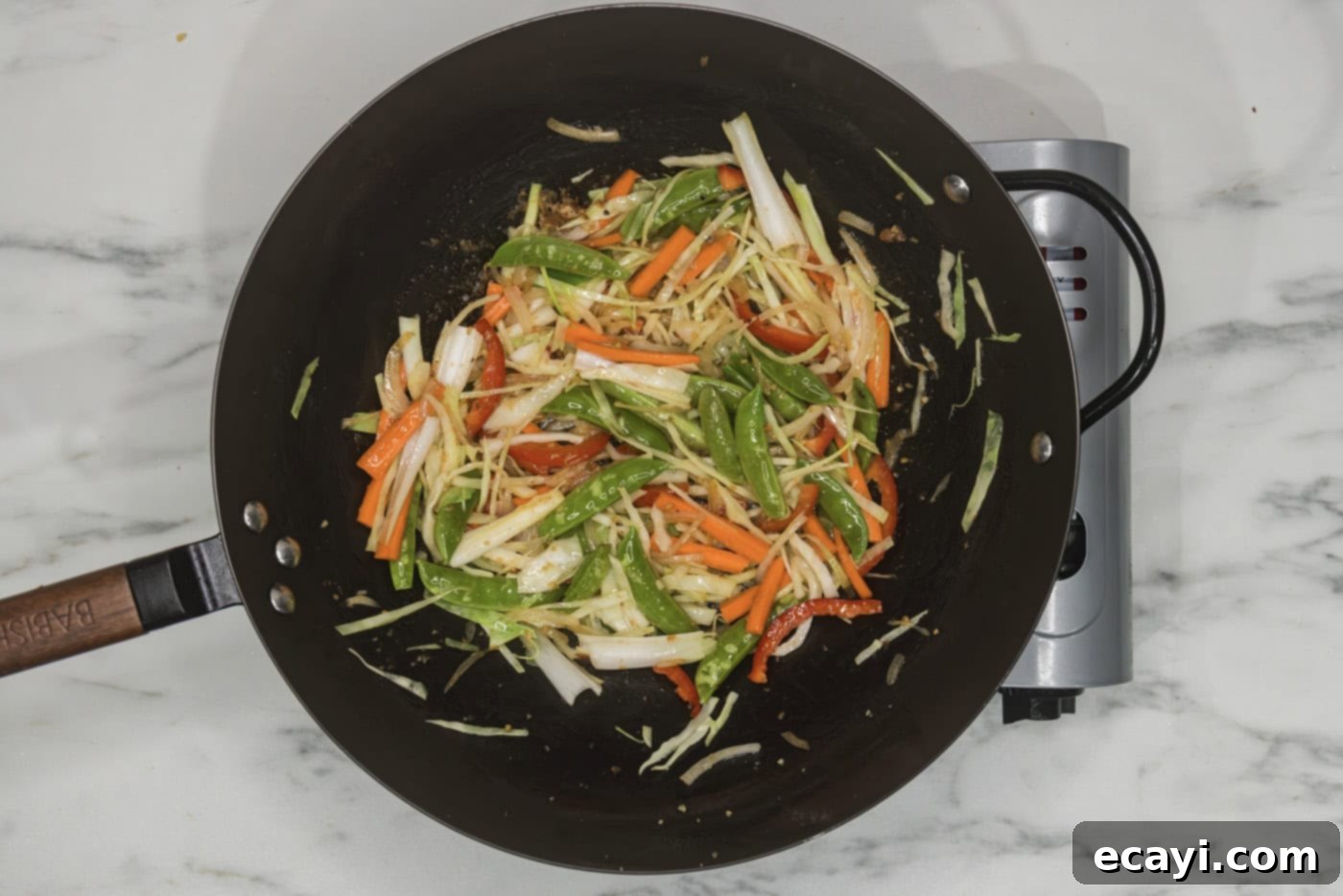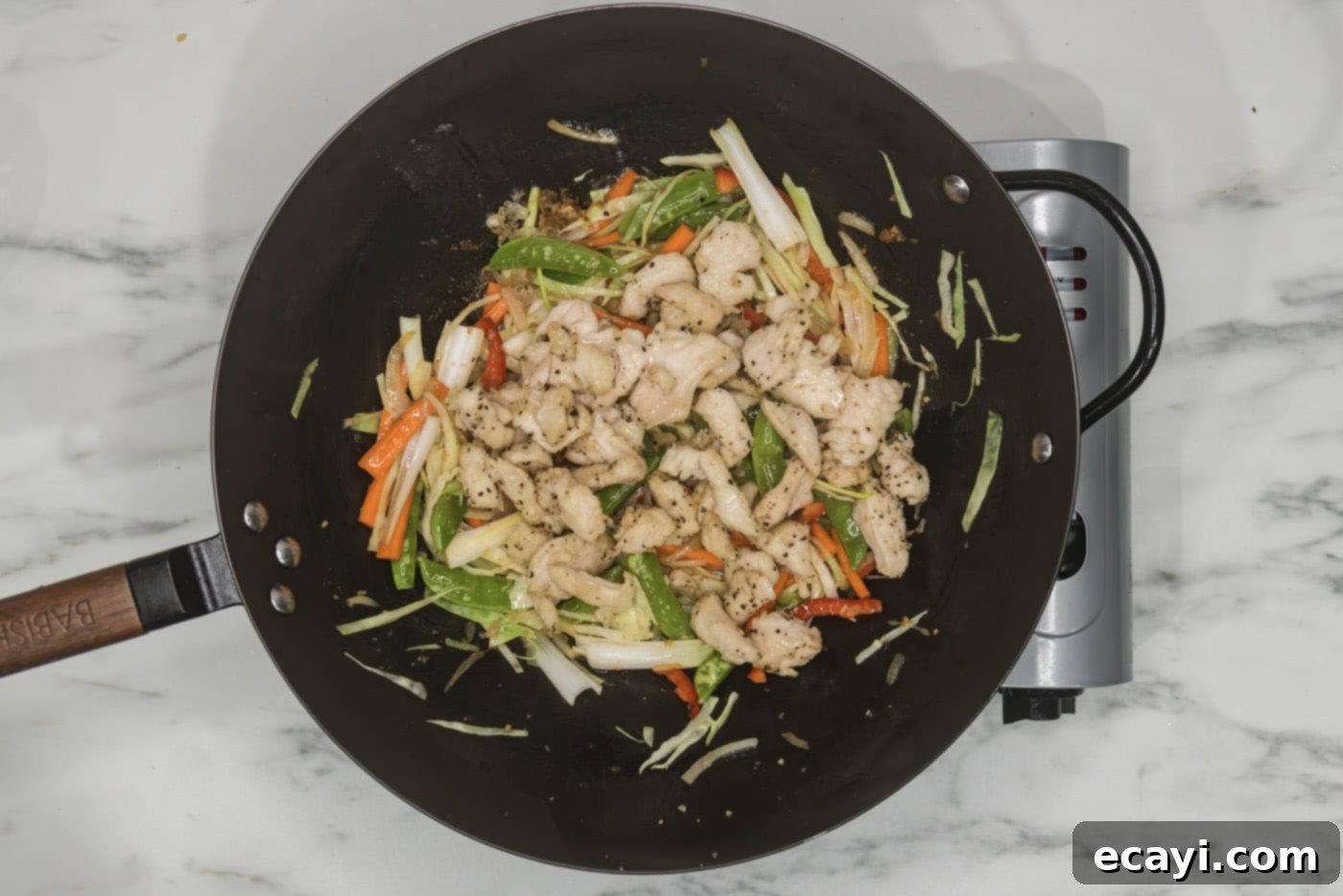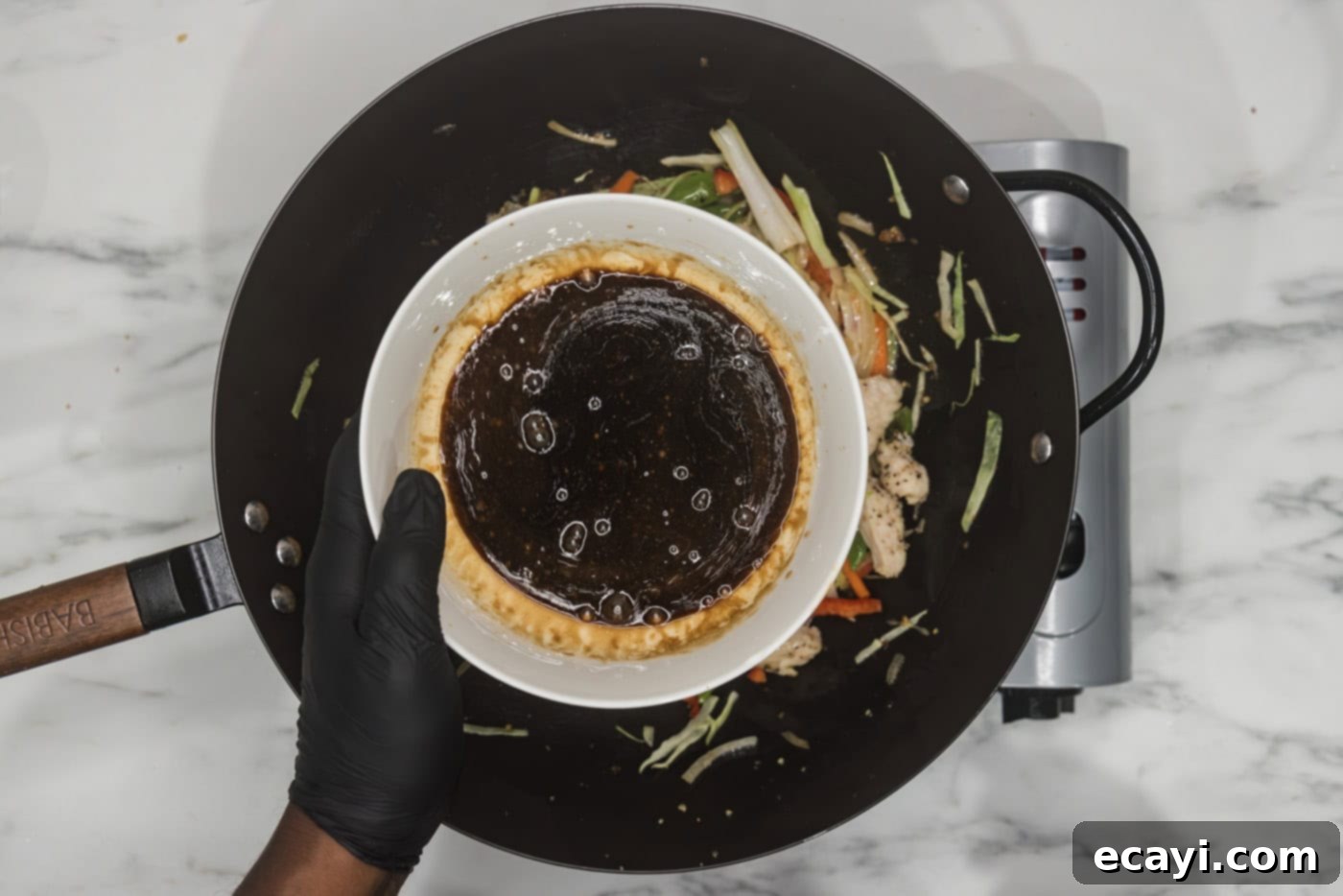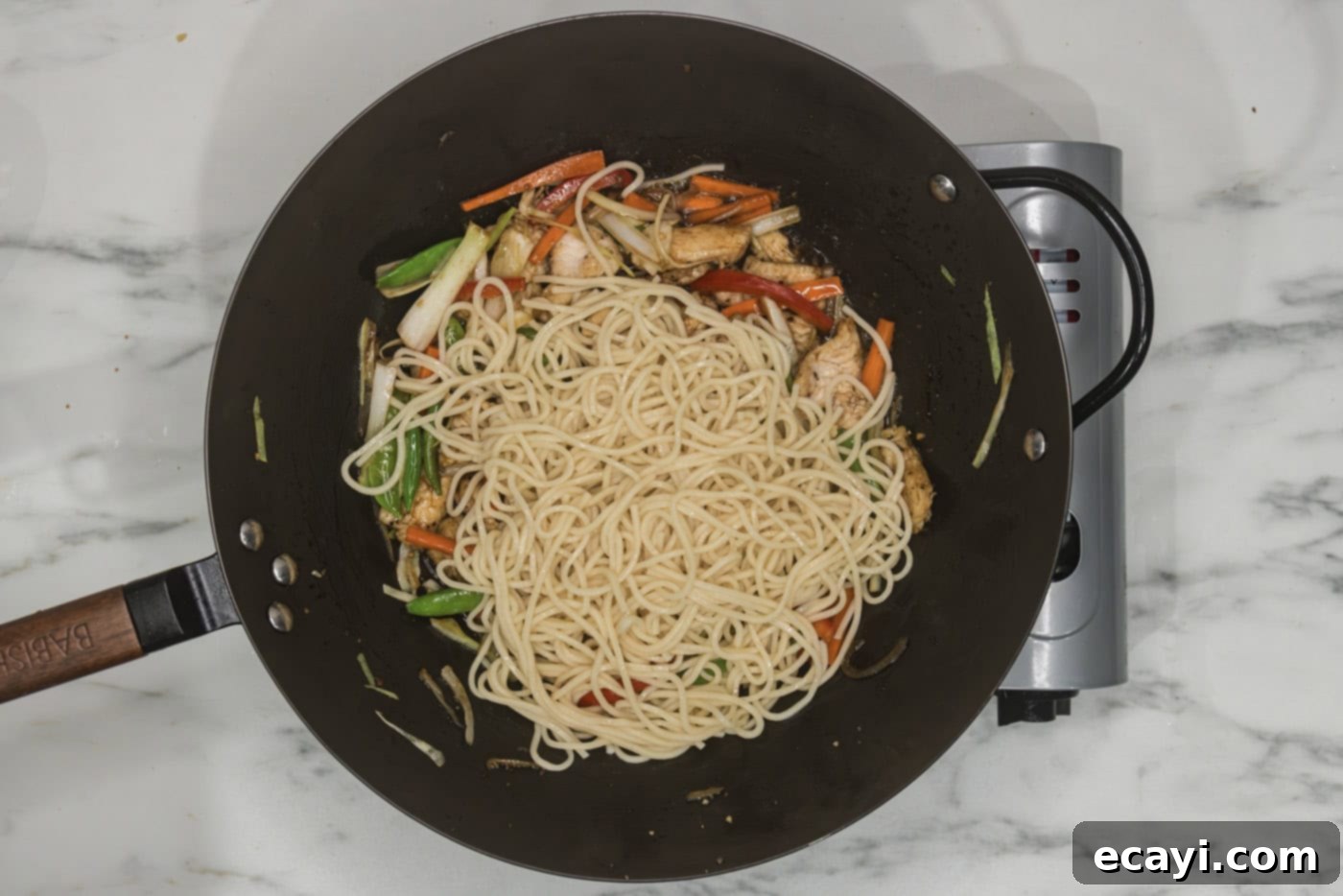Easy Homemade Chicken Lo Mein: Ditch the Takeout for This Flavorful Recipe!
Say goodbye to ordering in and hello to a deliciously simple homemade meal! This easy chicken lo mein recipe is a vibrant symphony of flavors and textures, featuring succulent chicken, an abundance of fresh, crisp vegetables, and tender noodles, all generously coated in a rich, savory umami sauce. It’s a dish so satisfying and straightforward to prepare, you’ll wonder why you ever opted for takeout.
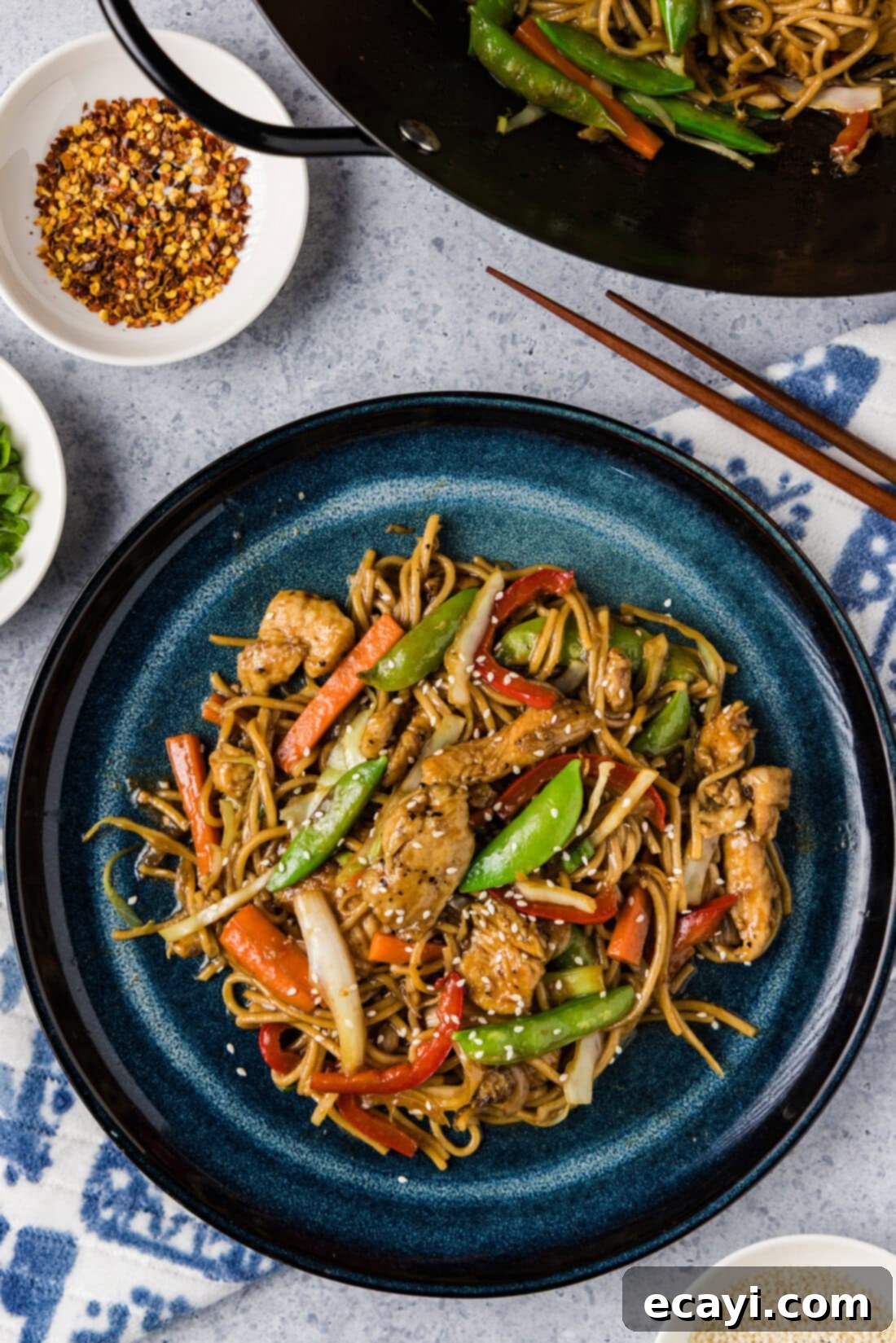
Why This Homemade Chicken Lo Mein Recipe is a Must-Try
There are countless reasons to make this chicken lo mein your new weeknight favorite. First and foremost, it’s remarkably simple to prepare, making it perfect for busy evenings when you crave something wholesome and flavorful without a lot of fuss. This recipe truly shines with its generous inclusion of fresh, colorful vegetables. Crisp onion, tender cabbage, vibrant bell peppers, crunchy snap peas, and sweet carrots not only add incredible texture but also a healthy boost of nutrients to every bite. These fresh ingredients are complemented by the aromatic kick of ginger and garlic, all brought together by our signature savory sauce that delivers that irresistible umami depth you often find in your favorite Asian dishes.
Beyond its incredible taste and ease, lo mein is a wonderfully versatile stir-fry. It’s an ideal way to utilize any lingering vegetables you might have in your refrigerator, preventing food waste and encouraging creativity in the kitchen. Don’t have chicken on hand? No problem! This recipe is incredibly adaptable. You can easily swap out the protein to create a robust beef lo mein, or even omit the meat entirely for a delightful vegetable lo mein, using whatever fresh produce you have on hand. The fundamental sauce and noodle base remain consistently delicious, no matter your chosen additions. We truly appreciate a recipe that offers so much flexibility and flavor!
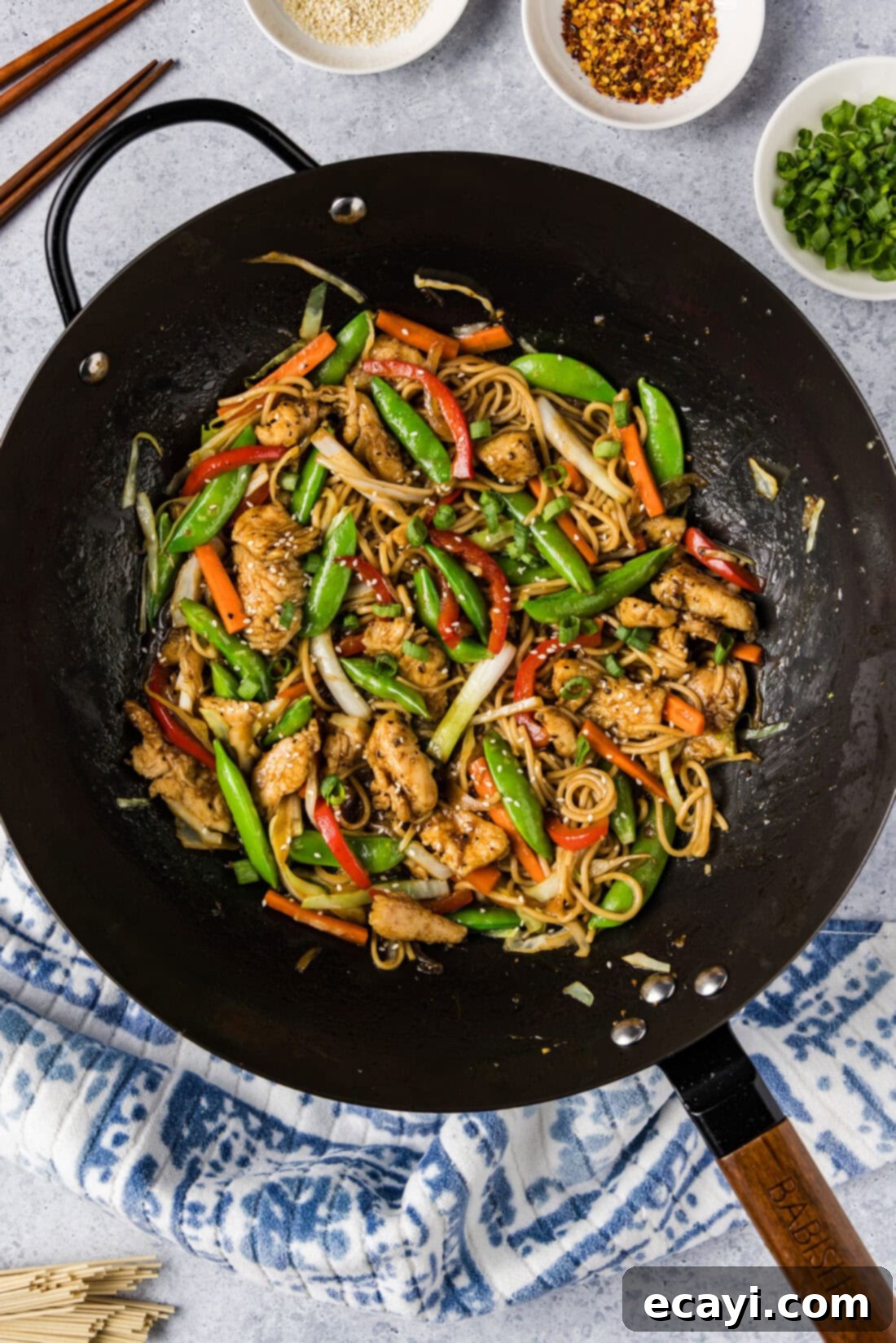
Key Ingredients for Your Delicious Lo Mein
Crafting the perfect chicken lo mein starts with the right ingredients. Below, you’ll find a general overview of what you’ll need. For precise measurements, a comprehensive list of ingredients, and detailed instructions, please refer to the printable recipe card located at the very end of this blog post. This section will give you a good idea of the fresh components that make this dish so special.
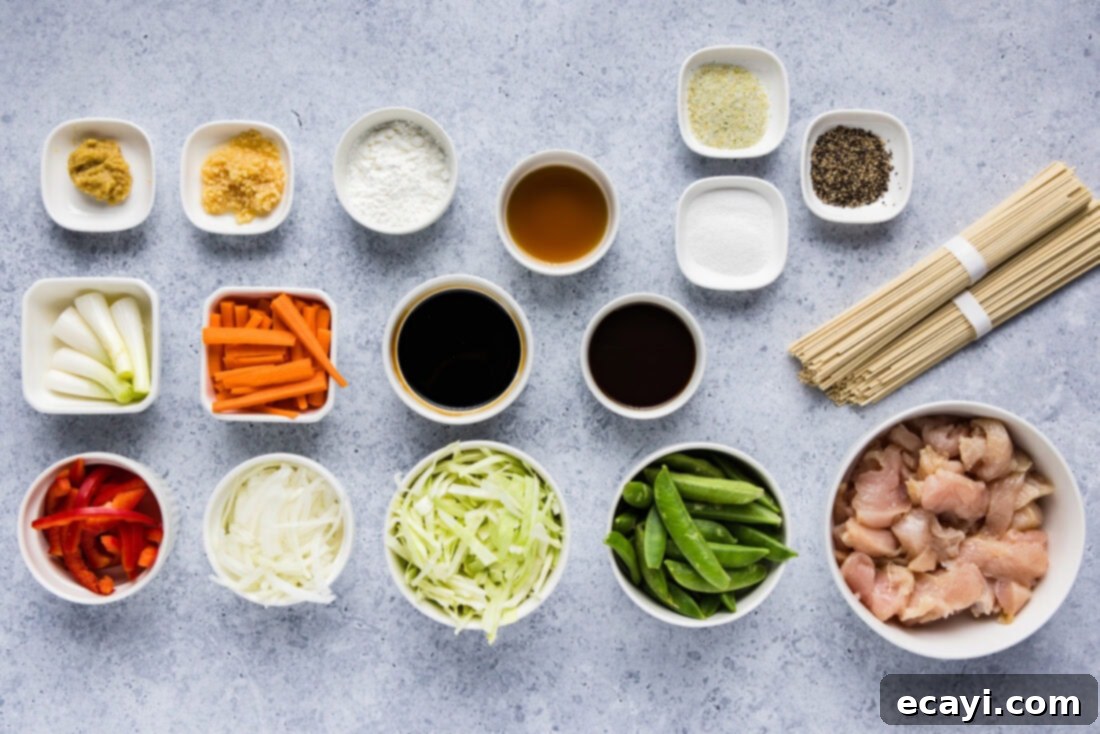
Ingredient Spotlight & Easy Substitutions
Understanding your ingredients is key to successful cooking, and this lo mein recipe offers fantastic flexibility. Here’s a closer look at the main components and how you can adapt them to your pantry or preferences:
NOODLES – The heart of any lo mein dish! Authentic lo mein noodles or Cantonese egg noodles are ideal for their distinctive chewy and tender texture, which perfectly absorbs the rich sauce. You’ll typically find these in the international or pasta aisle of most grocery stores. When selecting noodles, check the packaging carefully; some lo mein noodles come precooked and only require a quick reheat, while others are dried and need to be boiled first. Always follow the package directions for the best results. If true lo mein noodles are unavailable, don’t fret! Excellent alternatives include chow mein noodles (which are slightly crispier but still soft), ramen noodles (discard the seasoning packet), or even regular spaghetti noodles in a pinch. The goal is to have a long, sturdy noodle that can stand up to stir-frying. A helpful tip for precooked noodles: after draining, you can rinse them with cool water to halt the cooking process, then toss them with a small amount of olive oil. This prevents them from sticking together while you prepare the other elements of your dish.
VEGETABLES – This recipe is a fantastic canvas for your favorite veggies! We’ve included a vibrant mix of onion, cabbage, bell peppers, snap peas, and carrots, chosen for their complementary flavors, textures, and quick cooking times. Each adds a unique layer – from the subtle sweetness of carrots to the crunch of snap peas and the savory depth of cabbage. However, the beauty of a stir-fry lies in its adaptability. If you don’t have all these vegetables on hand, or simply want to experiment, feel free to substitute! Mushrooms add an earthy, umami flavor, broccoli florets provide a hearty crunch and excellent nutrients, and mini sweet peppers bring a burst of color and sweetness. Other great additions include bok choy, zucchini, water chestnuts, baby corn, or bamboo shoots. The key is to aim for a variety of colors and textures, ensuring they are cut into similar sizes for even cooking.
CHICKEN – Boneless, skinless chicken breasts, cubed into bite-sized pieces, are perfect for this recipe. They cook quickly and evenly, soaking up the flavors of the seasoning and sauce. The cornstarch coating isn’t just for flavor; it helps to tenderize the chicken, creates a slight crust when seared, and helps the sauce cling beautifully to each piece. If you prefer, chicken thighs can also be used for an even juicier result. For alternative proteins, consider thinly sliced beef (like flank steak or sirloin), shrimp (add towards the end of cooking as they cook very quickly), or firm tofu for a vegetarian option. Simply adjust cooking times as needed.
LO MEIN SAUCE – Our homemade sauce is what truly elevates this dish, providing that irresistible balance of sweet, savory, and umami. It’s a simple blend of soy sauce for its salty depth, sesame oil for its distinct nutty aroma, oyster sauce for a rich, slightly sweet, and savory body, and a touch of granulated sugar to balance the flavors. Cornstarch acts as a thickener, ensuring the sauce coats every noodle and piece of chicken and vegetable, giving the dish a luxurious, glossy finish.
AROMATICS (GARLIC & GINGER) – These two ingredients are non-negotiable for authentic Asian-inspired flavor. Freshly minced garlic and ginger provide a pungent, warming base that permeates the entire dish. While pre-minced versions can be convenient, using fresh garlic and ginger will always yield the most vibrant and fragrant results. Don’t skimp on these!
Step-by-Step Guide: How to Make Chicken Lo Mein
These step-by-step photos and detailed instructions are designed to help you visualize each stage of making this delicious chicken lo mein. For a fully printable version of this recipe, complete with exact measurements and detailed instructions, simply Jump to Recipe at the bottom of this post.
- In a medium bowl, thoroughly whisk together all the sauce ingredients and 2 teaspoons of the cornstarch until smooth. Set aside. This ensures the cornstarch is fully dissolved and prevents lumps in your final sauce.
- Place your cubed chicken pieces into a large bowl. Season them evenly with garlic salt and black pepper. Then, add the remaining 3 teaspoons of cornstarch and, using gloved hands, toss everything together until the chicken is completely coated. This cornstarch coating will help create a tender crust and allow the sauce to adhere perfectly.

- Heat the vegetable oil in a wok or a large, heavy-bottomed skillet over medium-high heat until it is shimmering. Add the coated chicken pieces in a single layer (work in batches if necessary to avoid overcrowding, which can steam the chicken instead of searing it). Stir-fry for 3-5 minutes, or until the chicken is no longer pink and has a light golden-brown sear. Remove the cooked chicken from the pan and set it aside, leaving any remaining oil and flavorful bits in the wok.

- To the remaining oil in the wok, add the minced garlic, minced ginger, sliced onion, sliced cabbage, sliced red bell pepper, snow peas (or snap peas), the white parts of the green onion, and julienned carrots. Stir-fry for 3-4 minutes, tossing continuously, until the vegetables are tender-crisp. You want them cooked through but still retaining a pleasant bite and vibrant color.

- Return the cooked chicken to the pan with the stir-fried vegetables. Give the whisked sauce another quick stir to ensure the cornstarch hasn’t settled, then pour it over the chicken and vegetables. Continue to stir-fry for 2-3 minutes, allowing the sauce to heat through and bubble gently. This simmering action will activate the cornstarch, causing the sauce to thicken and beautifully coat all the ingredients.


- Finally, add your cooked lo mein noodles to the pan. Using tongs or two spatulas, toss everything together thoroughly until the noodles, chicken, and vegetables are evenly coated in the rich, glossy sauce. Serve immediately and enjoy!

Frequently Asked Questions & Expert Tips for Perfect Lo Mein
Storing your leftover chicken lo mein properly ensures it remains delicious for another meal. Transfer any remaining lo mein to an air-tight container and store it in the refrigerator for up to 2-3 days. To reheat, the best method is in a skillet over medium-low heat with a dash of oil, stirring occasionally, until heated through. This helps the noodles regain some of their texture and prevents them from drying out. Alternatively, you can microwave it in short bursts, stirring in between, until warm.
While both chow mein and lo mein are popular Chinese-American noodle dishes made with wheat flour egg noodles, their preparation and resulting textures are distinctly different. The term “lo mein” translates to “tossed noodles,” indicating that the noodles are cooked separately, then tossed with the sauce, protein, and vegetables. This results in a softer, chewier noodle that is fully coated in sauce. “Chow mein,” on the other hand, translates to “fried noodles.” For chow mein, the noodles are often pan-fried, sometimes even crisped, after being boiled, before or after being combined with other ingredients. This typically gives chow mein a slightly drier, crispier texture, though still with tender elements. In essence, lo mein is more about the saucy, tender noodles, while chow mein often highlights a contrast between crispy and soft noodles.
Absolutely! Stir-fries are all about quick cooking, and having your “mise en place” (everything in its place) ready is crucial. You can chop all your vegetables hours or even a day in advance and store them in airtight containers in the refrigerator. The lo mein sauce can also be whisked together and stored in the fridge. This way, when it’s time to cook, you simply need to cook the chicken and stir-fry everything together, drastically cutting down on meal prep time.
If you enjoy a bit of heat, there are several easy ways to spice up your chicken lo mein. You can add a pinch of red pepper flakes along with the garlic and ginger, or incorporate a teaspoon or two of chili garlic sauce into your lo mein sauce. For a bolder kick, a drizzle of sriracha or a few drops of hot sesame oil when serving will do the trick.
While a traditional wok is ideal for stir-frying due to its high heat retention, sloped sides, and ability to keep ingredients constantly moving, a large, heavy-bottomed skillet or even a Dutch oven can work perfectly well. The key is to ensure your cooking vessel is large enough to comfortably hold all your ingredients without overcrowding, allowing them to stir-fry rather than steam. High heat is essential for developing flavor and achieving that desirable “wok hei” (breath of the wok) char.
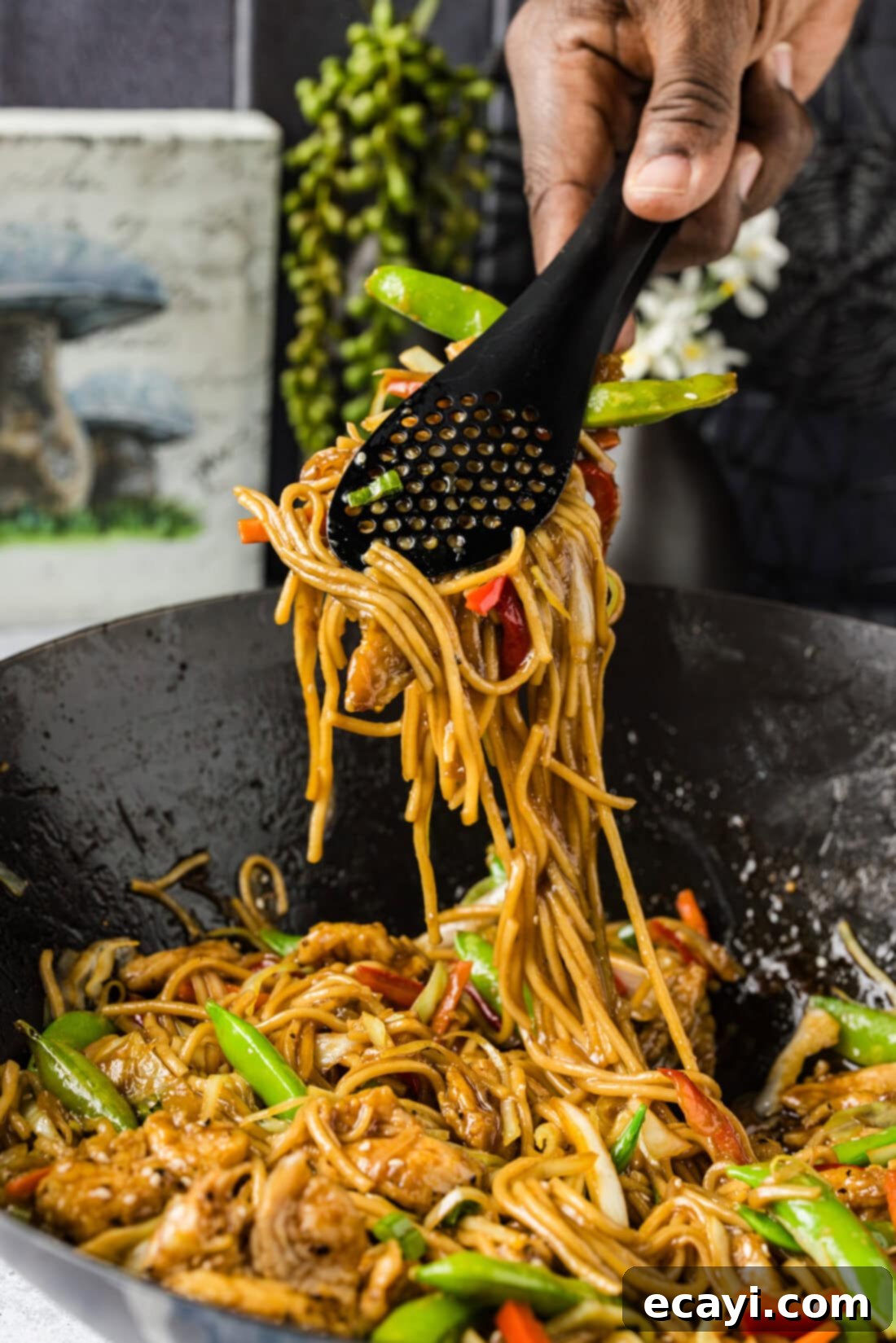
Delicious Serving Suggestions for Your Lo Mein
This chicken lo mein is incredibly satisfying and flavorful enough to stand on its own as a complete meal. However, if you’re looking to create a more elaborate feast or simply enjoy a variety of Asian-inspired flavors, there are many wonderful accompaniments. I personally love pairing it with some comforting egg drop soup, which offers a light and savory contrast to the richer noodles, or crispy egg rolls for an extra layer of texture. For a simple garnish that adds both flavor and visual appeal, sprinkle some toasted sesame seeds over the top just before serving. A side of blanched or stir-fried bok choy, perhaps with a touch of garlic, would also be a fantastic fresh addition. Don’t forget a side of chili garlic sauce for those who enjoy a little extra kick!
More Related Asian-Inspired Recipes to Explore
If you loved this chicken lo mein, you’ll be thrilled to discover more of our delightful Asian-inspired dishes:
- Classic Chow Mein
- Savory Beef Lo Mein
- Quick Teriyaki Noodles
- Hearty Vegetable Lo Mein
- Spicy Szechuan Chicken
Each of these recipes brings unique flavors and textures, perfect for expanding your home cooking repertoire and satisfying your cravings for delicious, easy-to-make Asian cuisine.
I absolutely love to bake and cook, and sharing my kitchen experiences with all of you brings me immense joy! Remembering to come back each day for new recipes can sometimes be a challenge, and that’s why I offer a convenient newsletter delivered straight to your inbox every time a new recipe is posted. Simply subscribe here and start receiving your free daily recipes, making it easier than ever to discover your next favorite meal!
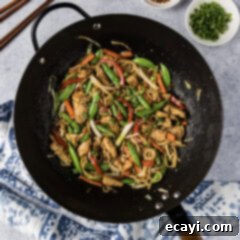
Chicken Lo Mein
IMPORTANT – There are often Frequently Asked Questions within the blog post that you may find helpful. Simply scroll back up to read them!
Print It
Pin It
Rate It
Save ItSaved!
Ingredients
- 5 teaspoons cornstarch divided
- 12 ounces boneless skinless chicken breasts cubed
- 1 teaspoon garlic salt
- ½ teaspoon black pepper
- 2 Tablespoons vegetable oil for frying
- 1 Tablespoon minced garlic
- 2 teaspoons minced ginger
- ½ cup sliced onion
- 1 cup sliced cabbage
- ½ cup sliced red bell pepper
- 1 cup snow peas or snap peas
- 5 green onions white parts only
- ½ cup julienned carrots
- 3 ½ ounces lo mein noodles cooked
Lo Mein Sauce
- ¼ cup soy sauce
- 1 Tablespoon sesame oil
- 2 Tablespoons oyster sauce
- 2 teaspoons granulated sugar
Things You’ll Need
-
Wok or large heavy bottomed skillet
-
Whisk
Before You Begin
- *This recipe primarily uses lo mein noodles that are already cooked. It’s crucial to consider this when preparing your ingredients. After cooking your noodles, you can rinse them with cool water to stop the cooking process, then place them back into a pot or large bowl of room temperature water until you’re ready to add them. Alternatively, lightly tossing the cooked noodles with a small amount of olive oil is an effective way to prevent them from sticking together while you prepare the rest of the recipe.
- Both dedicated lo mein noodles and Cantonese egg noodles are excellent choices for this dish. You’ll typically locate them in the international foods section or the pasta aisle of your local grocery store. Should you have difficulty finding them, suitable replacements include chow mein, ramen, or even regular spaghetti noodles.
- The vegetable selection is flexible! If you don’t have all the suggested vegetables on hand, feel free to use nice replacements such as sliced mushrooms (for umami depth), broccoli florets (for a hearty bite), or colorful mini sweet peppers.
Instructions
-
In a medium bowl, whisk together the soy sauce, sesame oil, oyster sauce, granulated sugar, and 2 teaspoons of the cornstarch until the mixture is completely smooth and lump-free. Set this homemade lo mein sauce aside.1/4 cup soy sauce, 1 Tablespoon sesame oil, 2 Tablespoons oyster sauce, 2 teaspoons granulated sugar
-
Place your cubed boneless, skinless chicken breasts into a large bowl. Season the chicken generously with garlic salt and black pepper. Add the remaining 3 teaspoons cornstarch and toss thoroughly with gloved hands until each piece of chicken is evenly coated. This coating will help create a tender texture and allow the sauce to adhere better.12 ounces boneless skinless chicken breasts, 1 teaspoon garlic salt, 1/2 teaspoon black pepper
-
Heat the 2 Tablespoons of vegetable oil in a wok or large heavy-bottomed skillet over medium-high heat until it begins to shimmer. Add the cornstarch-coated chicken to the hot oil and stir-fry until it is no longer pink in the center and has a light golden-brown exterior. Once cooked, remove the chicken from the pan and set it aside, leaving any residual oil and flavorful fond in the wok.2 Tablespoons vegetable oil
-
To the same pan with the remaining oil, add the minced garlic, minced ginger, sliced onion, sliced cabbage, sliced red bell pepper, snow peas (or snap peas), the white parts of the green onion, and julienned carrots. Stir-fry for 3-4 minutes, tossing frequently, until the vegetables are tender-crisp. They should still have a slight bite and bright color.1 Tablespoon minced garlic, 2 teaspoons minced ginger, 1/2 cup sliced onion, 1 cup sliced cabbage, 1/2 cup sliced red bell pepper, 1 cup snow peas, 5 green onions, 1/2 cup julienned carrots
-
Return the cooked chicken to the pan with the vegetables. Pour the prepared sauce over everything. Stir-fry for another 2-3 minutes to ensure all ingredients are well-coated and heated through. Allow the sauce to bubble gently for a few minutes; the cornstarch will activate, thickening the sauce to a glossy consistency.
-
Add the cooked lo mein noodles to the pan. Using tongs, gently toss all the ingredients together until the noodles, chicken, and vegetables are thoroughly mixed and evenly coated with the rich, savory lo mein sauce. Serve immediately and enjoy your homemade lo mein!3 1/2 ounces lo mein noodles
Expert Tips & FAQs
- To store leftovers, transfer them to an air-tight container and keep in the refrigerator for 2-3 days. Reheat in a skillet over medium-low heat with a dash of oil, stirring occasionally, until thoroughly warmed. This helps maintain the noodle texture and keeps the dish from drying out.
- The main difference between lo mein and chow mein lies in the preparation of the noodles. Lo mein noodles are boiled and then tossed with sauce and other ingredients, resulting in a softer, chewier texture. Chow mein noodles are often pan-fried, sometimes to a crisp, providing a firmer bite.
- To save time, prepare your vegetables and sauce in advance. Chop all your veggies and whisk the sauce ingredients together a day ahead and store them in separate airtight containers in the refrigerator. This “mise en place” makes assembly and cooking much faster.
- Feel free to customize your vegetables! If you don’t have all the recommended veggies, use what you have on hand. Broccoli, mushrooms, baby corn, and water chestnuts are all excellent additions.
Nutrition Information
The recipes on this blog are tested with a conventional gas oven and gas stovetop. It’s important to note that some ovens, especially as they age, can cook and bake inconsistently. Using an inexpensive oven thermometer can assure you that your oven is truly heating to the proper temperature. If you use a toaster oven or countertop oven, please keep in mind that they may not distribute heat the same as a conventional full sized oven and you may need to adjust your cooking/baking times. In the case of recipes made with a pressure cooker, air fryer, slow cooker, or other appliance, a link to the appliances we use is listed within each respective recipe. For baking recipes where measurements are given by weight, please note that results may not be the same if cups are used instead, and we can’t guarantee success with that method.
